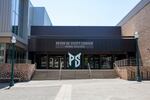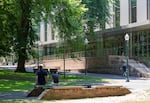The majority of Oregon’s public universities are returning to in-person learning as fall term gets underway. But, some Portland State University students and parents are frustrated with last-minute shifts from in-person classes to remote learning. The university says it’s just trying to stay flexible.
PSU launched its “Open For Fall, Open For All” campaign at the beginning of this year — a commitment to reopen the downtown Portland campus for in-person learning as well as lowering barriers to entry for incoming students.
A few parents of PSU students reached out to OPB saying that’s not what’s happening, as some students have seen classes originally slated to be taught in-person switched to online a week before the start of the term.
One parent questioned the messaging of “Open For Fall, Open For All” with these class changes. Another parent said their student is a senior at the university, and they saw all of their upper-division classes change to remote.
One PSU student posted on the Portland State Reddit page that they are at their “wits’ end” because all of their in-person classes switched to remote before the start of the term.
“I barely made it through last year. I’ll admit it, I’m not a good remote learner,” the student wrote.

Portland State University, Peter W. Stott Center
Hanin Najjar / OPB
Students and parents contacted by OPB declined to be named sources for this story, in order to protect their privacy.
Nya Mbock, president of the Associated Students of PSU, said she’s heard concerns about in-person classes switching to online, especially from students who are new to campus and early in their college career.
“Underclassmen, like freshmen and sophomores who didn’t have a freshman experience last year due to COVID, are really craving being on campus and being around other people and getting to know other students,” Mbock said. “I think engagement and getting involved is a huge part of the college experience, and it’s a huge part of what people are paying the exorbitant amount it costs to go to college these days to experience.”
At PSU, and many other colleges and universities, online courses are actually more expensive than in-person.
PSU’s online courses include a $35 per credit fee. The university said that fee “supports the development and delivery of the course including technology infrastructure and professional staff in our Office of Academic Innovation who work to ensure that these courses are delivered effectively and efficiently.”
Though, the fee only applies to courses that were designed to be delivered online from the start. So, students who signed up for an in-person class that was switched to remote won’t be charged the fee.
Ensuring flexibility
The university said it’s adhering to its Open For Fall, Open For All plan with 73% of classes offered with some in-person element this fall, including hybrid classes. The remainder of courses, 27%, will be taught entirely online.
PSU did not have a specific breakdown of all the courses that switched from in-person to remote before the start of the term. But, some include teacher licensure courses for students in the College of Education. Officials also noted that some course sections in PSU’s School of Social Work also went remote.
The university said teacher licensure courses were moved online because teaching candidates go into public schools and have interactions with potentially unvaccinated K-12 students. Similarly, some students in the School of Social Work also train in clinical settings around other people outside of the campus community.
In the university’s College of Liberal Arts & Sciences, some sections of larger courses, like chemistry and biology, switched to remote in response to student requests, PSU said.
Christina Williams, PSU’s Director of Media and Public Relations, said the ratio of course modalities this term, 73% in-person and 27% remote, is similar to what PSU saw before the pandemic.
“We had about 21% of our courses that were offered either fully online or fully remote in some way, and that had been growing every year in response to student need and demand,” Williams said.
At Oregon’s other two largest public universities, that ratio of in-person to remote classes looks very different.
Only a select number of courses will be taught online at the University of Oregon this fall — less than 5%, the institution said.
Oregon State is seeing a similarly small number of classes entirely online. The university has more than 4,000 class sections for the fall and only 66 are remote, or about 1.5% of classes, OSU said.
Williams with PSU said Portland State’s higher percentage of online classes has a lot to do with the student population.
“Flexibility has always been sort of where we start with our student body because we do have a lot of nontraditional students who have family members and other caregiving responsibilities,” Williams said.

Portland State University Library
Hanin Najjar / OPB
PSU student government president Mbock agrees with that. She’s a senior this year, and she has a total of five jobs on campus. Mbock said she opted to switch some of her classes to remote at the start of this term.
“I kind of realized that I would rather during my senior year take online classes, if it’s possible,” she said. “I think it fits better for my schedule, and I think that it makes more sense. I have community here, and I’m so grateful for it, and I don’t feel that need to be in-person and have those classes in-person.”
A concern that came up from one parent was if students living in the dorms would have time to get out of their residence hall contracts if their classes were switched to remote at the last minute.
Williams with PSU said those requests were granted.
“Anybody who had last minute changes to their course delivery methods and needed to get out of those contracts … they were being released,” Williams said. “That was done without penalty.”
Another reason PSU might be seeing more online classes than Oregon’s other two largest public universities is that PSU gave individual colleges and deans the option to change course modality for their sections. At OSU and UO, those decisions were made for the university as a whole.
“Starting in August, deans were really surveying their students and there were just a lot of requests for remote options,” Williams said. “We really wanted to be responsive for those requests while still honoring the fact that we wanted to be back on campus. … rather than making some unilateral decision, we really wanted to be as responsive as possible.”
Faculty perspectives
Some PSU community members still feel uncertain about a full return to campus with increased COVID-19 cases continuing in Oregon.
Ellie Harmon, Vice President of Communications for PSU’s faculty union — PSU’s chapter of the American Association of University Professors — said the union has been working all summer to ensure a safe environment for employees and students. It had initially pushed the administration to require COVID-19 vaccines.
“Amidst the recent delta (variant) surge that filled local hospitals to capacity, we have also been questioning the wisdom of fully returning to campus this September,” Harmon said.
Harmon said for PSU educators who are parents, there are still issues for securing childcare while working in-person. Some faculty members still have more general concerns about public health risks from the ongoing pandemic, as well.
“[W]e have many members who are trepidatious about our return to campus this fall,” she said. “We have also heard from many students that they, too, would like to continue pursuing their education remotely for a number of reasons.”
One solution PSU administrators have proposed this fall is a new “Attend Anywhere” course delivery modality, in which students can choose to either come to class in-person or attend remotely via Zoom. Williams with PSU said there are only a small number of classes being taught that way this fall — about 3%.
“We really do feel like that kind of flexibility and especially our Attend Anywhere pilot is where the future of higher education is going,” Williams said. “[I]t’s a pilot that we expect to learn from and refine.”
But Harmon, with the faculty union, is skeptical. She said the new course modality puts too much weight on instructors’ shoulders.
“[It] presumes that faculty can simultaneously facilitate a classroom of in-person students while also teaching to remotely attending students through Zoom,” Harmon said.
She said the PSU Faculty Senate’s Academic Quality Committee pointed out that the Attend Anywhere format may not give students the quality class experience they should be getting.
“As noted by the Faculty Senate’s Academic Quality Committee, this new modality is of dubious pedagogical quality and encourages faculty to simply deliver traditional lectures rather than engage students in more meaningful and interactive learning experiences,” Harmon said.
She added: “While many of our members are excited to engage with students and colleagues again in person, there remain significant uncertainties about how this fall term will play out.”

Portland State University Campus
Hanin Najjar / OPB

